Fertilizing hydrangeas in spring and summer: how to fertilize for lush flowering
An incredible delight in spring and summer causes the luxurious flowering of hydrangeas for most summer residents. However, nature requires its own and, in addition to the indisputable fact that hydrangea is a very beautiful plant, it is also a very moisture-loving plant that needs regular watering and does not allow the soil to dry out. In addition, in spring and summer, the shrub urgently needs additional nutrition, and not only macro-, but also necessarily microelements (especially iron).
By the way! Hydrangea grows well and blooms only on slightly acidic soils (i.e. 5.2-5.5 pH, maximum up to 6.2).
How to properly feed hydrangeas in spring and summer so that they bloom magnificently and for a long time, read further in our article.
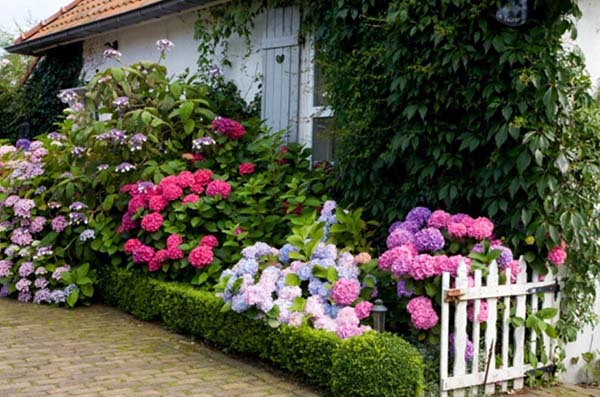
Content
- 1 Why fertilize hydrangeas in spring and summer
- 2 When to feed hydrangeas in spring and summer: optimal timing and scheme
- 3 How to properly feed hydrangeas
- 4 How to feed hydrangeas in spring and summer for flowering: options
- 5 Ready-made special fertilizers for hydrangeas
- 6 Fertilizers for acidifying the soil and changing the color of hydrangeas
Why fertilize hydrangeas in spring and summer
Hydrangeas, like any other plants (flowering shrubs), require all macro- and microelements for growth and development (flowering) (some to a greater extent, some to a lesser extent):
- Nitrogen - required for the active growth of powerful shoots and succulent leaves (a set of green mass).
Note! Excessive use of nitrogen fertilizers contributes to an overly active growth of vegetative mass to the detriment of flowering.
- Phosphorus - promotes lush, abundant (affects the size and number of flowers) and long flowering, and is also responsible for the root system of the plant (wintering).
- Potassium is very important in the budding and flowering phase (it also contributes to better flowering) in spring and summer, and in the fall - for laying future flower buds and successful wintering (affects the frost resistance of the plant).
- There are a lot of trace elements, and they are all responsible for different processes in plants. For example, bud setting and the brightness of flowers largely depend on magnesium.
Especially important for hydrangeas iron... In the case of a lack of it, chlorosis begins to actively develop in shrubs, to which they (hydrangeas) are very prone.
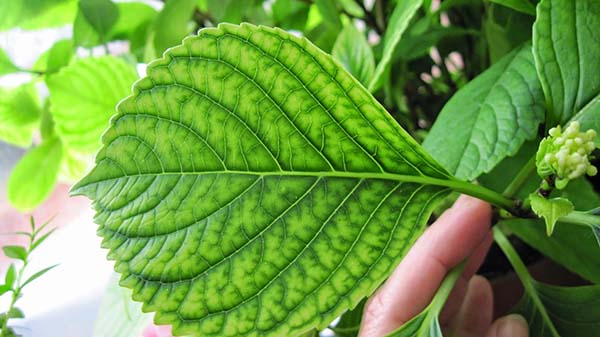
Thus, feeding hydrangeas in spring and summer:
- gives a rich green color to the leaves (let's say no to chlorosis!);
- stimulates the formation of buds;
- increases flowering duration;
- makes inflorescences (flowers) lush and voluminous;
- increases the intensity, and may even change the color of flowers.
When receiving all the macro-and microelements, plants get sick less, tolerate temperature extremes, lack and excess of moisture, as well as stress caused by other unfavorable conditions.
In other words, not only decorative attractiveness increases, but also the resistance of plants.
Note! If, when planting hydrangeas, you have already applied fertilizers (to the planting hole), then in the next 2-3 years the bushes do not need any feeding.
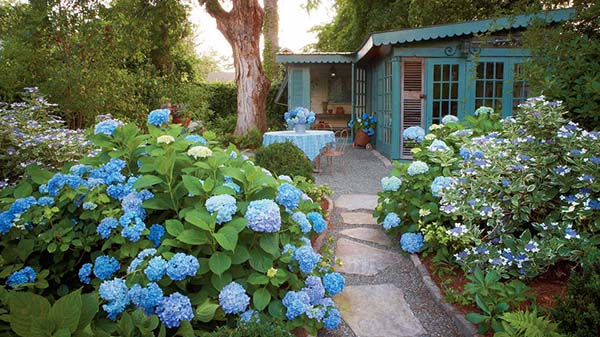
Of course, there are gardeners who never feed hydrangeas with anything, and they grow beautifully, bloom all summer and autumn. Actually, everything is in your hands, if you want - experiment.
When to feed hydrangeas in spring and summer: optimal timing and scheme
Many flower growers adhere to this scheme for feeding hydrangeas:
Naturally, the composition of the fertilizer differs from the season and the phase in which the plant is located.
- So, the first feeding of hydrangeas is made right after waking up (when the snow melts and the first green shoots appear) after spring pruning. It should consist mainly of nitrogen fertilizers (ammonium nitrate, urea, ammonium sulfate, or organic analogs). You can also add a little potassium (potassium sulfate or potassium sulfate, or other similar fertilizer) and phosphorus (superphosphate).
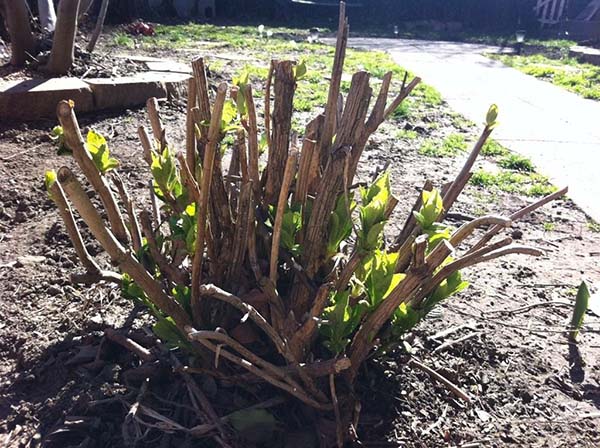
By the way! If you do not carry out the first feeding, then there will be nothing terrible, just do not forget about the second one (and add a little more nitrogen to it).
Worth knowing! In general, most gardeners feed hydrangeas in the spring only 1 time (before flowering) - with a full complex mineral fertilizer (with trace elements).
- The second is already during the beginning of budding (bud formation). At this point, the plant needs the maximum amount of phosphorus and potassium, as well as a little nitrogen. Alternatively, you can prepare a fertilizer based on potassium sulfate (potassium sulfate) and superphosphate, either use a complete mineral fertilizer such as nitroammophoska or diammophoska, or use special ready-made fertilizers.
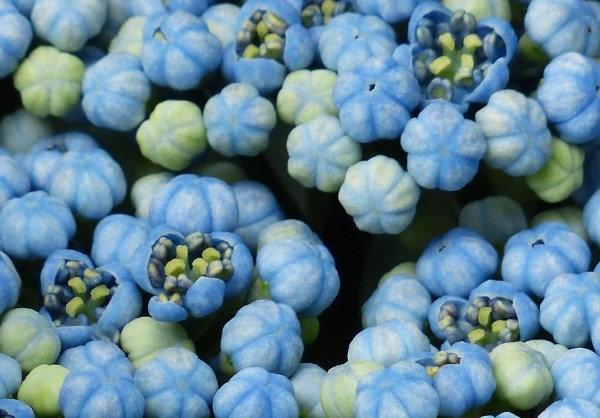
- During flowering - if desired (to prolong flowering) and if necessary, you can again feed it with potassium-phosphorus fertilizers with trace elements.
And also a couple of times necessarily acidify the soil with special solutions (read in a separate paragraph "Acidifiers").
- The last feeding of hydrangeas is done already at the end of flowering, i.e. in the fall... The purpose of this fall dressing is to help the shrub plant new flower buds for the coming year, as well as prepare the plant for winter. This means that it should be a phosphorus-potassium fertilizer (ideally - superphosphate, i.e. a lot of phosphorus + do not forget about potassium - potassium sulfate).
How to properly feed hydrangeas
Basic recommendations and rules for fertilizing hydrangeas:
- Before applying fertilizer, a small (very shallow) groove should be made around the near-stem circle of the bush (departing from it by 15-20 cm), where top dressing should be applied (in liquid or dry form).
After fertilizing, you can lightly sprinkle the grooves with humus or compost, and even better with sour peat (this will be both mulch and additional food).
- Before feeding the hydrangeas, it is recommended that you first spill the bushes with plain water, because it should be fertilized on wet soil, especially with mineral fertilizers.
By the way! If a good rain has recently passed, the ground is wet enough, then there is no point in watering.
Advice! In general, it is advisable to shed soil at least a couple, and even better a day before feeding.
- Top dressing should be done in the morning or evening, when the sun is not so active (not at its zenith), or in the afternoon in cloudy weather.
- Usually, in the spring are carried out precisely root dressing (in liquid form, but it is also possible in dry form - scatter the granules into circular grooves and fill in, fertilizers will gradually dissolve during watering or rains). A in summer, during the flowering period, you can perform and foliar feeding (by leaves).
Note! It is believed that foliar dressing is most effective when the plant especially needs certain trace elements (which is manifested in its appearance). For example, in the case of chlorosis.
Worth knowing! Foliar dressing cannot completely replace root dressing.
- As for the dosages (dilution proportions) and the timing of the application of certain fertilizers, always follow the instructions on the packages, do not rely on memory.
How to feed hydrangeas in spring and summer for flowering: options
There are many effective ways to feed hydrangeas in spring and summer. Some are more expensive, others are less, in any case, the choice is yours.
Important! All types of hydrangeas can and should be fed: tree-like, paniculate, large-leaved (garden), serrate and others (less popular).
Let's get to the bottom, namely, we will consider in detail and list the main fertilizers suitable for feeding hydrangeas in spring and summer (as well as in autumn):
Nitrogen fertilizers
Remember! They are used only in early spring, at the very beginning of plant growth (immediately after the snow melts).
And be careful with nitrogen fertilizers. If you overdo it, then the shrub will begin to drive the foliage, and the flowering will not be very bright and long.
Mineral nitrogen fertilizers:
- Urea (Carbamide) - 46% nitrogen (10-15 grams per 10 liters of water or per 1 square meter);
By the way! The site already has a separate article about how to use urea.
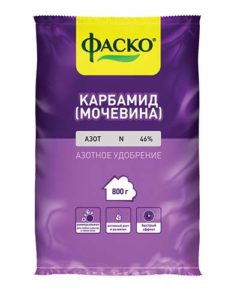
- Ammonium nitrate - 33-35% nitrogen (15-20 grams per 10 liters of water or per 1 square meter);
Advice! Also released a separate material on the use of ammonium nitrate in the garden.
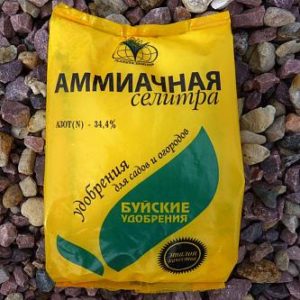
- Ammonium sulfate - 21% nitrogen (fertilizer sour, which means it is ideal for hydrangeas).
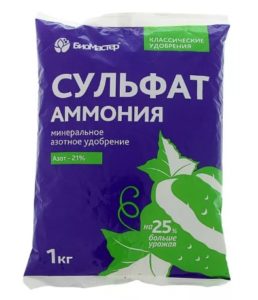
Organic fertilizers
- infusion chicken droppings (as a rule, initially diluted with water 1 to 20, and before adding another 1 to 3);
- infusion cow dung or mullein (1 in 10, and then another 1 in 2);
- green manure (nettle infusion).
Alternatively, you can additionally mulch hydrangeas (scatter in the near-stem circle)compost or humus... A even better with sour peat!
Complex mineral dressing
It is very convenient to use complex mineral fertilizers, which contain all the macronutrients.
So, hydrangeas in the spring can be fed with the following fertilizers:
- Nitroammofoska (nitrogen, phosphorus, potassium - 16% each).Prepare the solution at the rate of 20-30 grams per 10 liters of water. Pour about 5 liters under an adult bush.
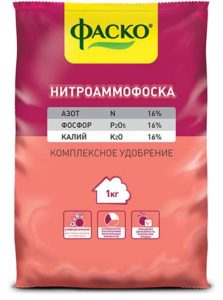
- Diammofoska - 10% nitrogen, 26% each phosphorus and potassium (20 grams per 10 liters of water).
But better after flowering or in autumn.
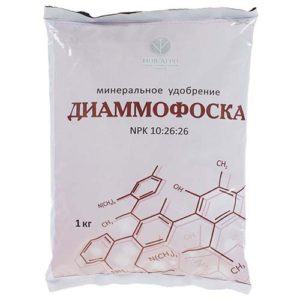
- Potassium monophosphate - 50% phosphorus and 33% potassium (10-15 grams per 10 liters of water).
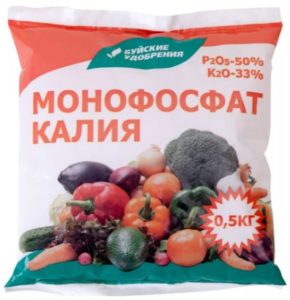
Note! The composition of these fertilizers does not include any trace elements, and it is very desirable to add them. Therefore, it is highly recommended to add humates to the solutions, which are described in more detail below - in the last paragraph.
Phosphate-potassium fertilizing
An excellent option for feeding hydrangeas during the budding period for lush flowering, as well as during direct flowering (and in autumn), can be the following combination of mineral fertilizers:
- Superphosphate - nitrogen 6-9%, phosphorus - 26-30% (10-20 grams per 10 liters of water or per 1 square meter).
By the way! More about how to apply superphosphate you can read in this material.
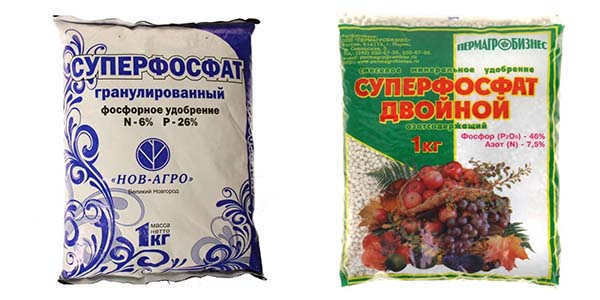
- Potassium sulfate (potassium sulfate) - 46-52% potassium (10-20 grams per 10 liters of water or per 1 square meter).
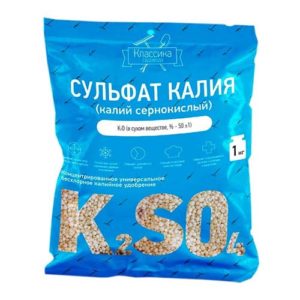
By the way! Instead of potassium sulfate (potassium sulfate), you can use potassium salt.
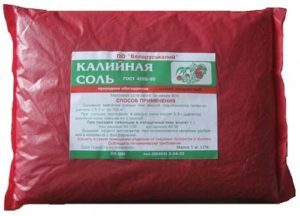
Better yet, takepotassium magnesium, which, in addition to potassium, contains such an important trace element for the flowering of hydrangeas, such as magnesium.
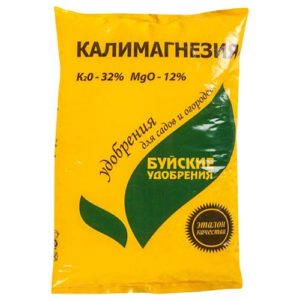
Note! For feeding hydrangeas not recommended to use wood ash, since it deoxidizes the soil (lowers its acidity), while the soil under hydrangeas, on the contrary, must be periodically acidified (increase its acidity). It's another matter if you want your hydrangeas to be pink (5.5-6.2 pH).
Fertilizers with humates and microelements
Very good to use humateswhich contribute to better absorption of mineral fertilizers. Therefore, you can prepare the solution first Potassium humate, and then add a complex mineral fertilizer to it, for example, the same nitroammophoska or potassium sulfate + superphosphate.
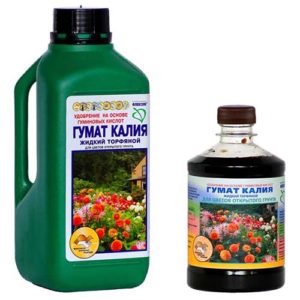
Unusual fertilizers
The following non-standard acidifying fertilizers can be quite effective means for feeding hydrangeas in spring and summer:
- kefir;
2 liters of kefir should be mixed with 10 liters of water.
- fermented baked milk;
- sour milk;
- curdled milk;
- milk serum;
- infusion of rye bread;
- yeast infusion (10 g of dry yeast and 3-5 teaspoons of sugar per 10 liters of water).
By the way! There is an opinion among the people that live beer also great for feeding hydrangeas in the summer during the flowering period.
In other words, fit any acidic foods... However, in them there should be no salt.
It is also very good to feed hydrangeas. potassium permanganate (slightly pink solution)... Such dressing will strengthen the shoots, they will be more flexible, make the flower stalks larger, and the flowering itself will last longer (due to the potassium included in it).
Important! It should be understood that such top dressing cannot be compared in efficiency with mineral fertilizers.
Ready-made special fertilizers for hydrangeas
If you do not want to bother (you are a "lazy" florist) and are able to spend a little more money (yes, ready-made fertilizers are always more expensive), then you can purchase one of special complex fertilizers for hydrangeas, rhododendrons, azaleas and heather crops, which already contains all the macro- and microelements, for example:
- Fertika Crystalon for hydrangeas and azalea (liquid with trace elements);

Also liquidFertika Crystalon for hydrangeas and azalea can be in this form:
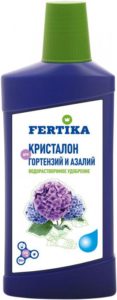
- Agricola «For hydrangeas"(Liquid, with trace elements and humates;
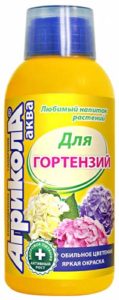
- Bona forte«Fertilizer for blue hydrangeas»(Liquid, with trace elements, vitamins and succinic acid);
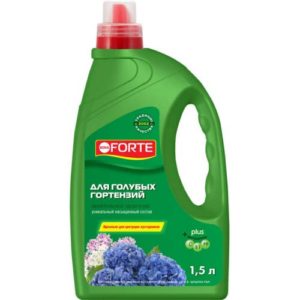
- Fertilizer for hydrangeas from "Buysk fertilizers"(Powder and granules, with trace elements).
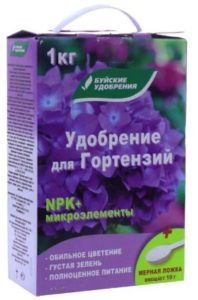
Note! The last two fertilizers are capable of changing the color of hydrangeas from pink to blue.
Sustained-release fertilizers
- Particularly popular are special fertilizers of long-term (prolonged) action (granular, it is advisable to apply dry in the holes along the diameter of the bushes, and then water), which are enough to add to the soil only once a season (in early spring). For example, "Hydrangea and Rhododendrons»FromPokon (Pocon).
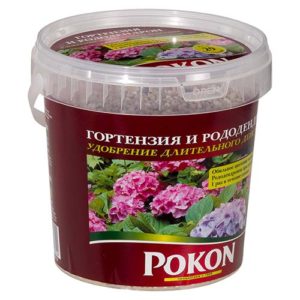
- Long lasting fertilizer for hydrangeas from ASB Greenworld;
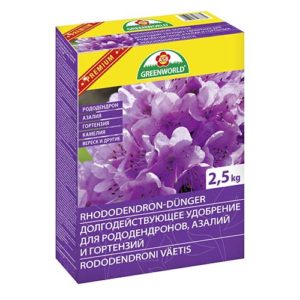
Video: spring feeding hydrangeas with prolonged-release fertilizers
Fertilizers for acidifying the soil and changing the color of hydrangeas
If you want hydrangeas to bloom luxuriously and not suffer from chlorosis, then the soil under them should always be acidic, or rather slightly acidic (5.2-5.5 pH), which means that it needs to be acidified periodically (at least - once a month per flowering period, or even better - once every 14-21 days).
Note! Hydrangeas are "acid-loving" plants, which means that in alkaline soil they absorb any nutrition very poorly.
Therefore, in no case feed them with ash and other deoxidizers (of course, unless you want to change the color to pink).
You can acidify the soil under hydrangeas with the following compositions and solutions:
- weakly acidic electrolyte solution (10 ml per 10 l of water);
- apple cider vinegar (100 ml of 9% vinegar per 10 liters of water);
- citric acid (20-40 g per 10 l of water).
Advice! Moreover, it is very desirable to additionally add iron chelate to the above solutions or inkstone (20-30 grams per 10 liters).
How to change the colorhydrangea
You can regulate the color of hydrangeas by changing the acidity of the soil. The principle is as follows: the more acidic the soil (5-5.5 pH), the more violet or blue the color will be, and, conversely, if the acidity is lower (6-6.2 pH), then the inflorescences will be pink or crimson.
To reduce acidity you need to use soil deoxidizers such as dolomite flour, wood ash, lime, chalk.
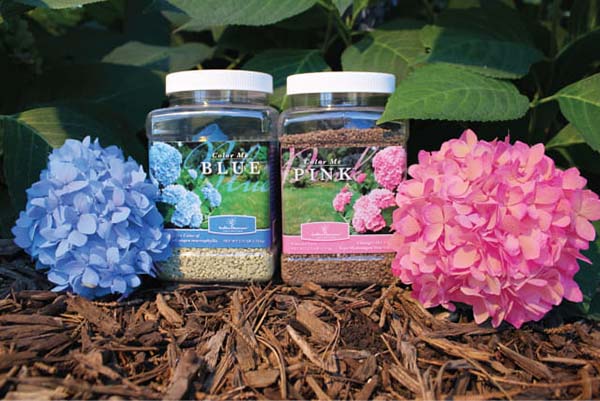
Interesting! Sometimes you can see that hydrangea bushes have inflorescences of different colors. It's not hard to guess what this means 🙂
P.S. The soil has different acidity.
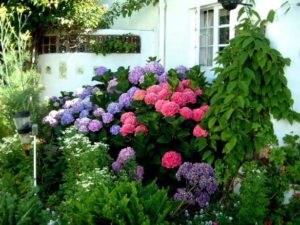
However!Make blue hydrangeas out of pink not so simple (but from blue, pink is very possible). Even if you have very acidic soil, but there is not enough movable aluminum in it, then the color change will not follow.
Alternatively, you can prepare a solutionpotassium alum and water (30-40 grams per 10 liters, consumption for adult bushes is up to 2-3 liters). Or dig into the ground aluminum sulfate (up to 500 grams per 1 square meter).
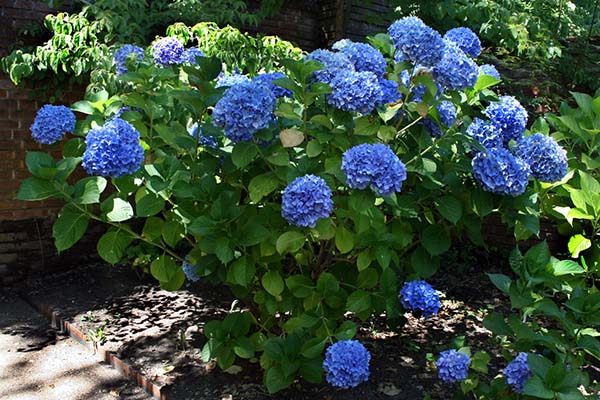
Video: how to change the color of a hydrangea to blue or pink
Or you can do much easier and purchase special ready-made products for changing the color of hydrangeas:
- Bona Forte "Means for changing the color of hydrangeas" in liquid form;
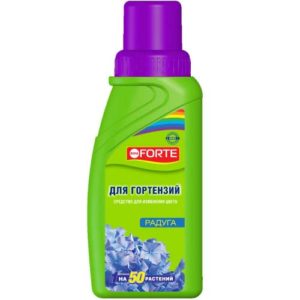
- either in powder;
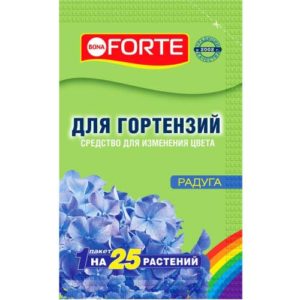
Note! And here change the color of hydrangeaswhich initially have white inflorescences, not allowed.
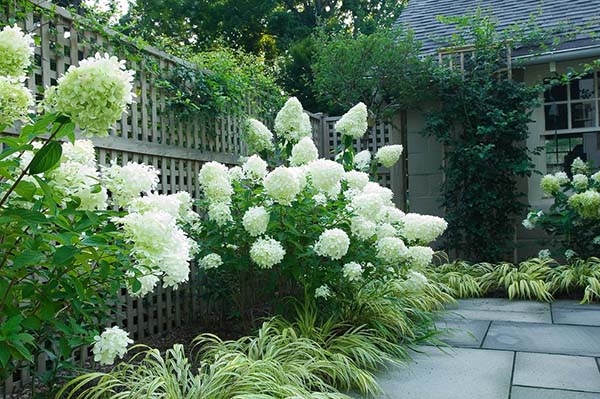
Thus, if you want your hydrangeas to bloom lushly and for a long time, then do not forget to feed the bushes in the spring and summer, as well as in the fall. And be sure to acidify the soil periodically. Good luck!
Video: caring for hydrangea, how to feed and how to water


Thank you very good article thank you very much
Thank you for the information, everything is very clear and accessible, and without "water".
Great article. Only in the list of fertilizers, please put “and” or “or”. For example, I did not understand, are all these fertilizers necessary for hydrangeas or a choice? And group them somehow. Thanks in advance.
Thanks for your feedback! At each stage of hydrangea development, you only need to use one fertilizer, of course, of your choice. If you need nitrogen, then one of the nitrogen is urea, ammonium nitrate or ammonium sulfate (the latter is preferable, since this fertilizer acidifies the soil well).
Hope, thank you, good article, what I was looking for and picked up good fertilizer, I began to look, but in Ukraine there are no such "offensive", maybe some osmokot will do?
Hello!
Have you picked up a special (= ready-made) fertilizer for hydrangeas, right?
This is what I found on the websites of Ukrainian online garden stores: Florovit, BIOPON, Royal Mix, Dobrivo, Lauren, Actiwin (you need it with the mark “for hydrangeas”, they are also suitable “for rhododendrons and azaleas”).
Hello! From my panicle hydrangea, a young sapling, got this year, the leaves turned red, what would that mean? once fed with vinegar and again - infusion of a loaf with sour milk. The color has not changed.
Thank you.
Good day!
Most likely, the problem is in the insufficient acidity of the soil ... Sour milk, although it can slightly acidify the soil, is very, very weak (then milk whey is better - 1 liter and 9 liters of water). And what was the concentration of the vinegar solution?
It is better to try spilling with a solution of apple cider vinegar (100 ml of 9% vinegar per 10 liters of water) or citric acid (20-40 g per 10 liters of water). If you can find it, then a weakly acidic electrolyte solution (10 ml per 10 liters of water). Moreover, such "sour" dressings need to be done 3-4 with an interval of 7-10 days.
A very interesting article, especially about dressing, I have two types of hydrangea, I want to buy a blue one, but I doubt that it will be just that.
Hello! The main thing is not to buy a white hydrangea, you cannot change its color, and you can achieve a blue tint of the inflorescences by acidifying the soil to pH 5.0-5.5 with special acidifying fertilizers.